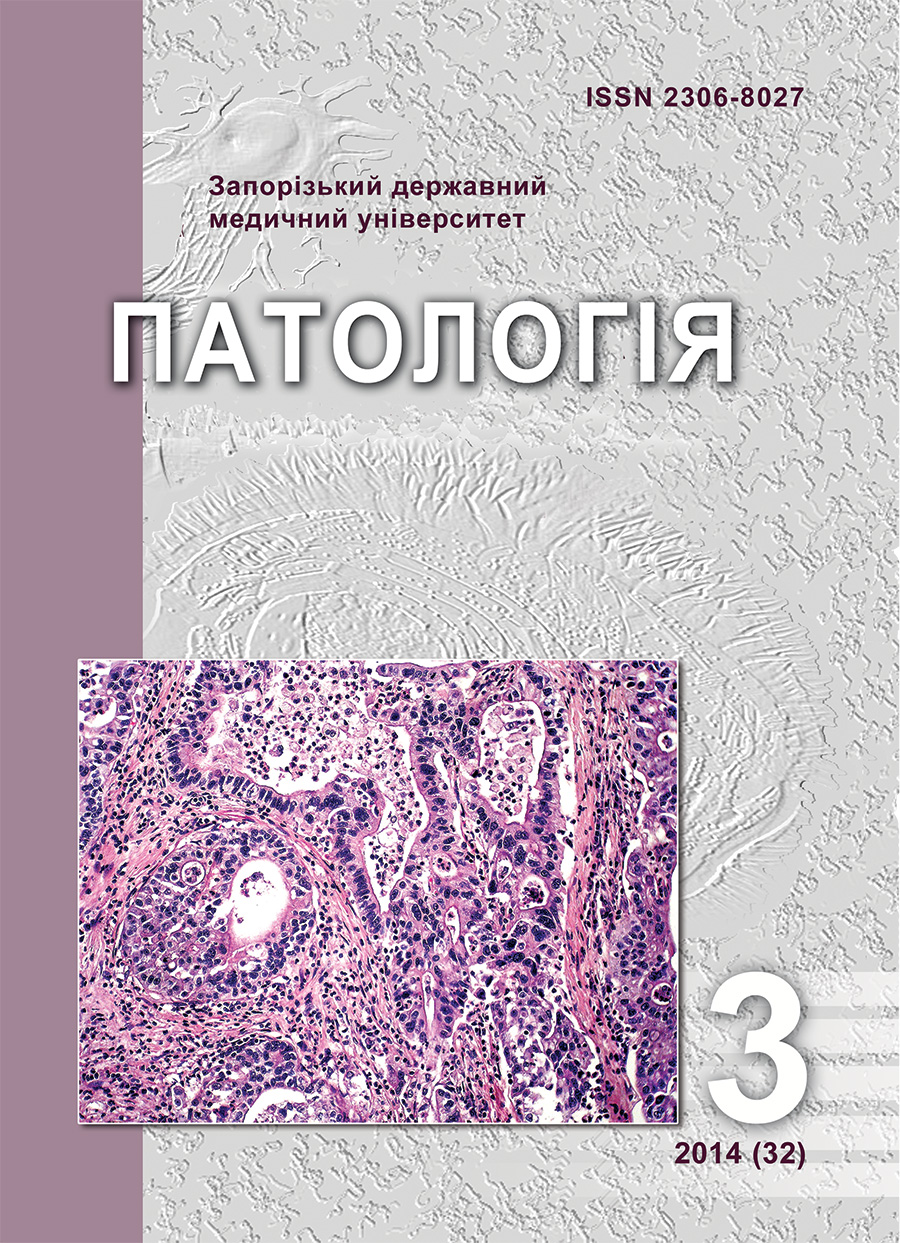Immunohistochemical features of some connective tissue components of kidney in mesangiocapillary glomerulonephritis type I and diffuse lupus glomerulonephritis
DOI:
https://doi.org/10.14739/2310-1237.2014.3.36940Keywords:
Mesangiocapillary Glomerulonephritis, Lupus Nephritis, ImmunohistochemistryAbstract
Aim. To study immunohistochemical features of some connective tissue components of kidney in mesangiocapillary glomerulonephritis type I and diffuse lupus glomerulonephritis.
Methods and results. The features of some components of connective tissue in kidney biopsies of patients with mesangiocapillary glomerulonephritis type I and diffuse lupus glomerulonephritis were studied using immunohistochemical, morphometrical and statistical methods of data analysis.
Conclusion. The peculiarities of vimentin and smooth muscle actin distribution in the glomerular and tubular-interstitial apparatus of kidney during these two conditions were identified that can be used for facilitation of differential diagnostic optimization and prognosis of the disease.
References
Ivanova, M. D. (2012). Imunohistokhimichni markery interstytsiinoho fibrozu pry pervynykh proliferatyvnykh hlomerulonefrytakh [Immunohistochemical markers of interstitial fibrosis in primary proliferative glomerulonephritis]. Ukrainskyi naukovo-medychnyi molodizhnyi zhurnal, 1, 229. [in Ukrainian].
Dyadyk, А. I., & Dyadyk, Е. А. (Eds) (2011). Rukovodstvo po nefrologhii. [Manual on hephrology]. Кyiv: Chetverta khvylia. [in Ukrainian].
Dyadyk, Е. А., Shatokhina, Т. V., Ivanova, M. D., & Khmara, E. V. (2009) Morfologicheskie kriterii v prognozirovanii techeniya i iskhoda glomerulonefritov [Morphological criteria in predicting the course and outcome of glomerulonephritis]. Morfolohichnyi stan tkanyn i orhaniv system orhanizmu v normi ta patolohii Proceedings of the Scientific and Practical Conference, (pp. 54–55). Ternopil. [in Ukrainian].
Dyadyk, О. О., Vasylenko, І. V., Shatokhina, Т. V., Ivanova, M. D., & Khmara, E. V. (2009). Mozhlyvosti zastosuvannia suchasnykh metodiv morfolohichnoi diahnostyky pryzhyttievoho doslidzhennia nyrok khvorykh na rizni formy hlomerulonefrytu [Possibilities of application of modern methods of diagnosis in vivo morphological study of the kidneys of patients with various forms of glomerulonephritis]. Zdobutky klinichnoi ta eksperymentalnoi medytsyny, 1(10), 45–48. [in Ukrainian].
Beck, L., & Salant, D. (2008). Glomerular and tubulointerstitial diseases. Prim. Care Office Pract., 35, 264–296.
Colvin, R. B., Chang, A., & Kambham, N. (2011). Diagnostic Pathology: Kidney Diseases. Boston: Lippincott Williams & Wilkins Publisher.
Christensen, E. I., & Verroust, P. J. (2008). Interstitial fibrosis: tubular hypothesis versus glomerular hypothesis. Kidney International, 74, 1233–1236.
Eddy, A. A. (2011). Scraping fibrosis: UMODulating renal fibrosis. Nat. Med., 17(5), 553–555.
Tang, R., Yang, C., Tao, J. L., You, Y. K., An, N., Li S. M., et al. (2011). Epithelial-mesenchymal transdifferentiation of renal tubular epithelial cells induced by urinary proteins requires the activation of PKC-alpha and betaI isozymes. Cell Biol. Int., 35, 953–959
Downloads
How to Cite
Issue
Section
License
Authors who publish with this journal agree to the following terms:
Authors retain copyright and grant the journal right of first publication with the work simultaneously licensed under a Creative Commons Attribution License that allows others to share the work with an acknowledgement of the work's authorship and initial publication in this journal.

Authors are able to enter into separate, additional contractual arrangements for the non-exclusive distribution of the journal's published version of the work (e.g., post it to an institutional repository or publish it in a book), with an acknowledgement of its initial publication in this journal.
Authors are permitted and encouraged to post their work online (e.g., in institutional repositories or on their website) prior to and during the submission process, as it can lead to productive exchanges, as well as earlier and greater citation of published work (SeeThe Effect of Open Access).

